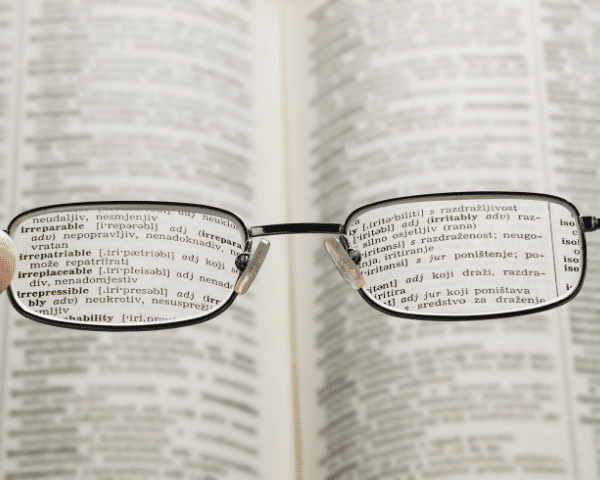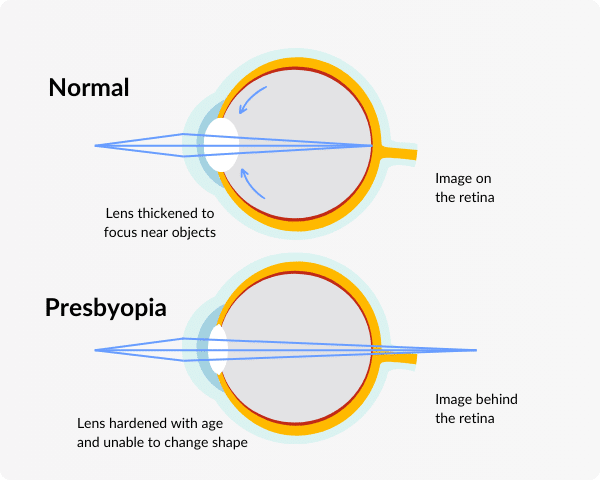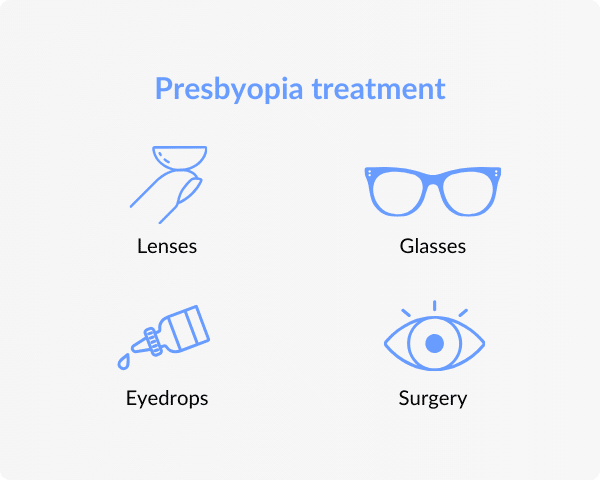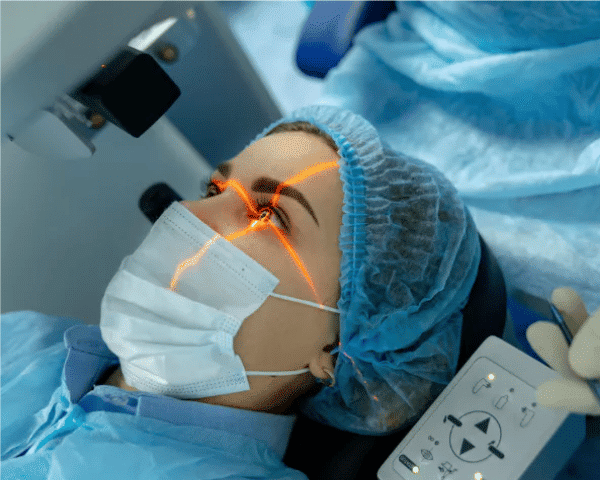Everything You Need to Know About Presbyopia

Reviewed by
Maria Horan FBDO
If you’re thinking that your vision just isn’t what it used to be, you’re probably right. As you age, you may find that you’re struggling with things you’ve never had issues with like reading fine print.
This is normal, and completely expected due to something called presbyopia.
Presbyopia is a very common eye condition. In fact, everyone above the age of 45 is expected to experience it as it consists in an age-related loss of near vision that can be easily corrected with eyeglasses, contact lenses or surgical options.
What is presbyopia?
Presbyopia is a vision condition that causes blurred close-range vision. This is because as you grow older, your lens in your eyes lose their natural ability to focus on nearby objects.
As this worsens and the eye struggles more and more with near vision, the presbyopia will make it harder for you to see clearly when performing certain activities such as reading, writing or looking at a computer screen.

Presbyopia symptoms
As you age, you may notice both a loss in visual acuity (clarity) when looking at objects at close range, and blurred vision when trying to read fine print.
This can be a good indicator of presbyopia, though first symptoms are not always immediately noticeable.
Presbyopia symptoms include:
- Squinting, especially when looking at close-range objects.
- Blurred vision.
- Difficulties reading small print.
- Headache and eye strain after reading.
- Reduced focusing ability, leading to the need to hold reading material by holding at arm’s length.
- Needing brighter conditions to read or work in.
- Eye fatigue.
If you are experiencing any of these symptoms, you should ask your eye doctor for a comprehensive eye exam. That said, it’s best to get an eye screening around age 40, regardless of if you have symptoms.
This is because presbyopia tends to manifest around that age, with anyone above age 40 being at risk.
Given the age-related nature of the condition, regular eye examinations can help stay on top of it by identifying vision change and any signs of sight impairment early on.
Symptoms similar to those of presbyopia can also occur in young people, though they are more often caused by eye fatigue from digital screens. That said, there’s no way of excluding vision impairments without a screening.
That’s why it’s best to keep an eye out for these symptoms and consult your optician if you notice any changes in your eye health whatsoever, regardless of age.
Ask our optical dispenser
Your request was successfully submitted!
DID YOU KNOW?
Presbyopia has been around for ages! The name comes from Modern Latin and finds its roots in the ancient Greek terms presbus (old man) and ōps (eye).
What causes presbyopia?
Your eye uses a natural crystalline lens to focus light on your cornea, enabling you to see. This is similar to how cameras use a lens to focus light on the film and capture an image.
Just as the camera lens changes size when you zoom in and out of the picture, your eye’s lens is also somewhat flexible. The muscles surrounding it contract and relax as you focus, allowing it to change shape and serve as your eye’s autofocus system.

Though this mechanism tends to work very well when you’re young, your lens gets thicker as you age. This makes it much less flexible, which in turn causes the autofocus system to stop working when looking at close range items.
Presbyopia is the medical term for an age-related decrease in near vision as a result of lens rigidity.
Unlike other vision conditions like myopia and astigmatism, it isn’t born of a defect in the eye’s anatomy but is instead an unavoidable consequence of getting older.
Presbyopia treatment

Researchers aren’t sure why the eye loses flexibility as we age, but it happens to everyone. Though it may be frustrating, it’s nothing more than an unfortunate side effect of aging that can be easily corrected through treatment options.
Common treatments include glasses, contact lenses, medication and refractive surgery, giving you plenty of options to manage your presbyopia.
Glasses for presbyopia
Eyeglasses are the most common treatment options for presbyopia. As your eye’s natural lens loses flexibility, glasses can correct this by providing external support that allows your eyes to focus on near distances.
Reading glasses are often the best option if presbyopia is the only vision condition present. These help eyes focus when performing close range tasks, like reading a book or computer screen.

Instead, multifocal addition lenses (MALs) are used when treating presbyopia in people with multiple vision conditions.
Thanks to the different vision areas on the lenses, they can be fit with more than one prescription. This allows you to correct both near vision, intermediate vision and distance vision with a single pair of glasses.
Contact lenses for presbyopia
Contact lenses are an alternative to glasses for treating presbyopia symptoms. These can be either monovision, bifocal or multifocal contact lenses.
Just as was the case with glasses, bifocal and multifocal contact lenses are fit with multiple prescriptions and cater to both near and distance vision correction.
Monovision contact lenses are instead lenses fit for distance vision in one lens, and near vision in the other. You can also get modified monovision contact lenses where one eye uses a multifocal contact lens and the other one uses a distance vision lens.
They are an effective solution, though they can take some time to get used to as they require switching between one eye and the other to see different distances.
Whether it’s best to wear glasses or contact lenses depends on your individual lifestyle and needs. An optician can help you understand what’s best for you.
Medication for presbyopia
Though traditionally there was no medication available for presbyopia, the FDA has recently approved the use of pilocarpine hydrochloride ophthalmic solution as a viable treatment option.
This consists of prescription eye drops that reduce the size of your pupils, helping your eyes focus on closer objects. They are effective for up to six hours and need to be used on a daily basis.
Surgery for presbyopia
Corrective surgery is also an option for presbyopia symptoms.
Monovision LASIK surgery is a form of surgical correction used to create an effect similar to monovision contact lenses. This is achieved by correcting one eye for near vision and the other eye for distance vision.
Then there’s PresbyLASIK, a new form of corrective laser surgery developed specifically for presbyopia that is now undergoing clinical trials in the U.S.
This procedure uses a special laser (called an excimer laser) to help regain vision at multiple distances. It does this by creating a multifocal ablation pattern directly on the eye’s clear front surface.

Alongside this, other experimental treatments such as corneal inlays are being developed and tested. One promising study focuses on injecting an elastic gel into the structure in the eye that contains the natural lens (called the capsular bag).
This is a more permanent treatment that could potentially offer a significant improvement in visual function.
In theory, the gel could replace the natural lens and serve as a new, more elastic one. In addition, some people undergoing cataract surgery may be able to achieve clear vision across all ranges by choosing presbyopia-correcting intraocular lens.
Your vision is expected to worsen as you get older, and that’s okay. Presbyopia is a frustrating part of the aging process, but it can easily be corrected by staying on top of it.
Remember, it’s important to get the recommended vision screenings as an optician will be able to check for early signs of vision conditions and adjust your prescription as needed.
And if you still have doubts about glasses and contacts for presbyopia? Don’t worry about it, feel free to ask our opticians anything. They’re here to help you see more clearly!
Reference list
Peng MY, Hannan S, Teenan D, Schallhorn SJ, Schallhorn JM. (2018), Monovision LASIK in emmetropic presbyopic patients, Clin Ophthalmol. doi: 10.2147/OPTH.S170759. PMID: 30233129; PMCID: PMC6130303.
https://www.ncbi.nlm.nih.gov/pmc/articles/PMC6130303/
Fernández J, Molina-Martín A, Rocha-de-Lossada C, Rodríguez-Vallejo M, Piñero DP (2023), Clinical outcomes of presbyopia correction with the latest techniques of presbyLASIK: a systematic review, Eye (Lond). doi: 10.1038/s41433-022-02175-3. Epub 2022 Jul 21. PMID: 35864161; PMCID: PMC9998429.
https://pubmed.ncbi.nlm.nih.gov/35864161/
Paley GL, Chuck RS, Tsai LM. (2016), Corneal-Based Surgical Presbyopic Therapies and Their Application in Pseudophakic Patients, J Ophthalmol. doi: 10.1155/2016/5263870. Epub 2016 Mar 9. PMID: 27051527; PMCID: PMC4804036.
Related articles







































